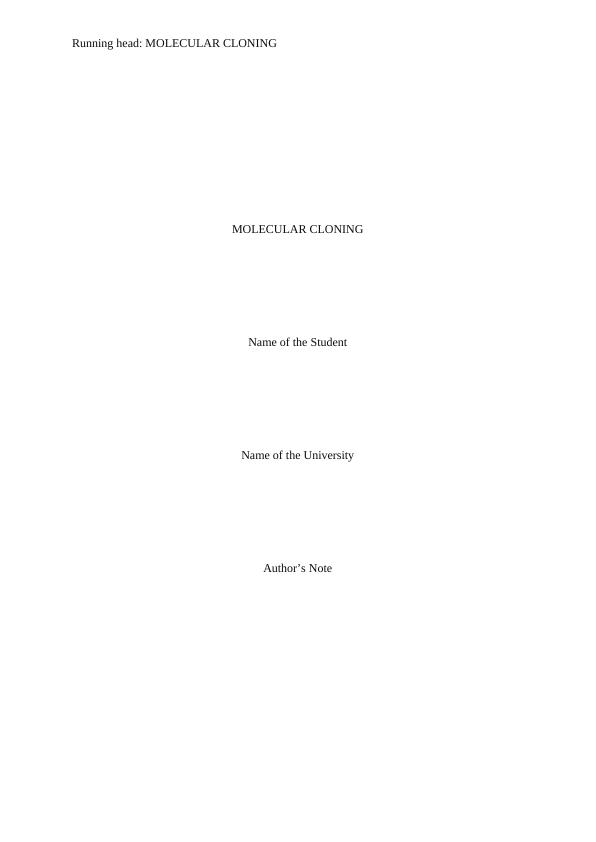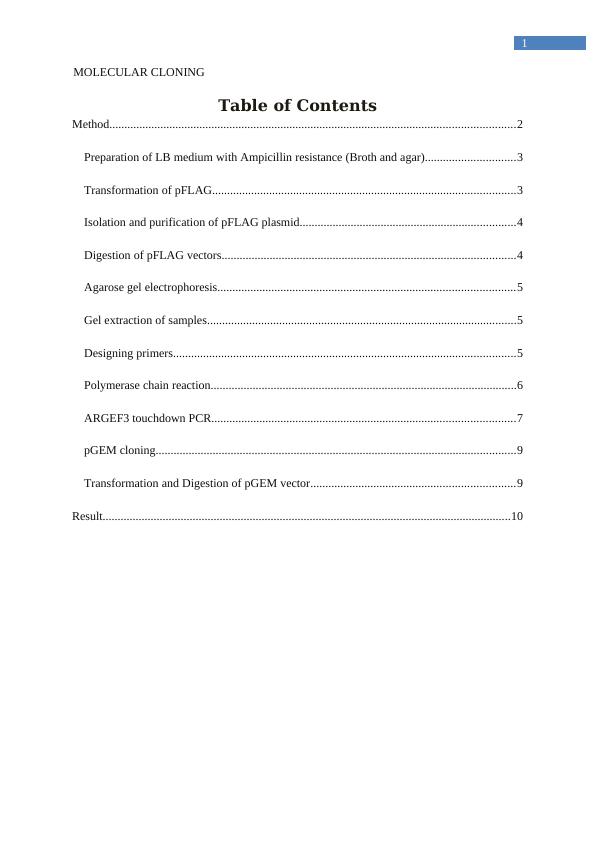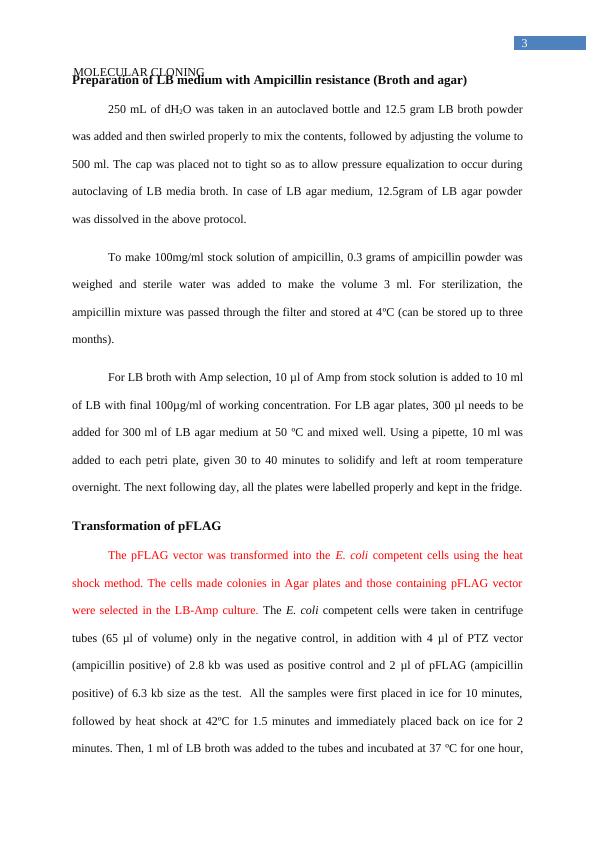Molecular Cloning: Methodology and Techniques
Added on 2022-11-07
19 Pages2782 Words134 Views
Running head: MOLECULAR CLONING
MOLECULAR CLONING
Name of the Student
Name of the University
Author’s Note
MOLECULAR CLONING
Name of the Student
Name of the University
Author’s Note

1
MOLECULAR CLONING
Table of Contents
Method.......................................................................................................................................2
Preparation of LB medium with Ampicillin resistance (Broth and agar)..............................3
Transformation of pFLAG.....................................................................................................3
Isolation and purification of pFLAG plasmid........................................................................4
Digestion of pFLAG vectors..................................................................................................4
Agarose gel electrophoresis...................................................................................................5
Gel extraction of samples.......................................................................................................5
Designing primers..................................................................................................................5
Polymerase chain reaction......................................................................................................6
ARGEF3 touchdown PCR.....................................................................................................7
pGEM cloning........................................................................................................................9
Transformation and Digestion of pGEM vector....................................................................9
Result........................................................................................................................................10
MOLECULAR CLONING
Table of Contents
Method.......................................................................................................................................2
Preparation of LB medium with Ampicillin resistance (Broth and agar)..............................3
Transformation of pFLAG.....................................................................................................3
Isolation and purification of pFLAG plasmid........................................................................4
Digestion of pFLAG vectors..................................................................................................4
Agarose gel electrophoresis...................................................................................................5
Gel extraction of samples.......................................................................................................5
Designing primers..................................................................................................................5
Polymerase chain reaction......................................................................................................6
ARGEF3 touchdown PCR.....................................................................................................7
pGEM cloning........................................................................................................................9
Transformation and Digestion of pGEM vector....................................................................9
Result........................................................................................................................................10

2
MOLECULAR CLONING
Method
The ARFGEF3 gene was identified by whole exome sequecing (WES) by Ivonne
Olivares, a PhD student at the University and brain tumor genomic cDNA was made and
provided from the mRNA isolated by her. To validate the mutations, Sanger sequencing was
incorporated. In order to do the PCR, the appropriate primers were designed and provided by
Ivonne. After doing PCR and running the gel the expected band was 518 bp. The main aim of
the study is to validate the gene insert along with evaluation of the mutation in comparison to
the normal gene without any mutation. The overall methodology of molecular cloning of the
ARFGEF3 gene has been summarized in the flow chart below.
Figure 1: The figure illustrates the flow chart for molecular cloning of ARFGEF3 gene into
pFLAG vector.
MOLECULAR CLONING
Method
The ARFGEF3 gene was identified by whole exome sequecing (WES) by Ivonne
Olivares, a PhD student at the University and brain tumor genomic cDNA was made and
provided from the mRNA isolated by her. To validate the mutations, Sanger sequencing was
incorporated. In order to do the PCR, the appropriate primers were designed and provided by
Ivonne. After doing PCR and running the gel the expected band was 518 bp. The main aim of
the study is to validate the gene insert along with evaluation of the mutation in comparison to
the normal gene without any mutation. The overall methodology of molecular cloning of the
ARFGEF3 gene has been summarized in the flow chart below.
Figure 1: The figure illustrates the flow chart for molecular cloning of ARFGEF3 gene into
pFLAG vector.

3
MOLECULAR CLONING
Preparation of LB medium with Ampicillin resistance (Broth and agar)
250 mL of dH2O was taken in an autoclaved bottle and 12.5 gram LB broth powder
was added and then swirled properly to mix the contents, followed by adjusting the volume to
500 ml. The cap was placed not to tight so as to allow pressure equalization to occur during
autoclaving of LB media broth. In case of LB agar medium, 12.5gram of LB agar powder
was dissolved in the above protocol.
To make 100mg/ml stock solution of ampicillin, 0.3 grams of ampicillin powder was
weighed and sterile water was added to make the volume 3 ml. For sterilization, the
ampicillin mixture was passed through the filter and stored at 4ºC (can be stored up to three
months).
For LB broth with Amp selection, 10 μl of Amp from stock solution is added to 10 ml
of LB with final 100μg/ml of working concentration. For LB agar plates, 300 μl needs to be
added for 300 ml of LB agar medium at 50 ºC and mixed well. Using a pipette, 10 ml was
added to each petri plate, given 30 to 40 minutes to solidify and left at room temperature
overnight. The next following day, all the plates were labelled properly and kept in the fridge.
Transformation of pFLAG
The pFLAG vector was transformed into the E. coli competent cells using the heat
shock method. The cells made colonies in Agar plates and those containing pFLAG vector
were selected in the LB-Amp culture. The E. coli competent cells were taken in centrifuge
tubes (65 μl of volume) only in the negative control, in addition with 4 μl of PTZ vector
(ampicillin positive) of 2.8 kb was used as positive control and 2 μl of pFLAG (ampicillin
positive) of 6.3 kb size as the test. All the samples were first placed in ice for 10 minutes,
followed by heat shock at 42ºC for 1.5 minutes and immediately placed back on ice for 2
minutes. Then, 1 ml of LB broth was added to the tubes and incubated at 37 ºC for one hour,
MOLECULAR CLONING
Preparation of LB medium with Ampicillin resistance (Broth and agar)
250 mL of dH2O was taken in an autoclaved bottle and 12.5 gram LB broth powder
was added and then swirled properly to mix the contents, followed by adjusting the volume to
500 ml. The cap was placed not to tight so as to allow pressure equalization to occur during
autoclaving of LB media broth. In case of LB agar medium, 12.5gram of LB agar powder
was dissolved in the above protocol.
To make 100mg/ml stock solution of ampicillin, 0.3 grams of ampicillin powder was
weighed and sterile water was added to make the volume 3 ml. For sterilization, the
ampicillin mixture was passed through the filter and stored at 4ºC (can be stored up to three
months).
For LB broth with Amp selection, 10 μl of Amp from stock solution is added to 10 ml
of LB with final 100μg/ml of working concentration. For LB agar plates, 300 μl needs to be
added for 300 ml of LB agar medium at 50 ºC and mixed well. Using a pipette, 10 ml was
added to each petri plate, given 30 to 40 minutes to solidify and left at room temperature
overnight. The next following day, all the plates were labelled properly and kept in the fridge.
Transformation of pFLAG
The pFLAG vector was transformed into the E. coli competent cells using the heat
shock method. The cells made colonies in Agar plates and those containing pFLAG vector
were selected in the LB-Amp culture. The E. coli competent cells were taken in centrifuge
tubes (65 μl of volume) only in the negative control, in addition with 4 μl of PTZ vector
(ampicillin positive) of 2.8 kb was used as positive control and 2 μl of pFLAG (ampicillin
positive) of 6.3 kb size as the test. All the samples were first placed in ice for 10 minutes,
followed by heat shock at 42ºC for 1.5 minutes and immediately placed back on ice for 2
minutes. Then, 1 ml of LB broth was added to the tubes and incubated at 37 ºC for one hour,

End of preview
Want to access all the pages? Upload your documents or become a member.